 |
Home | Charity | Feedback |
Japan:
Hakone - Mt. Fuji,
Kyoto,
Osaka,
Tokyo
Kyoto, Japan: On the Sakura trail by Prakash Bang, Editor in Chief 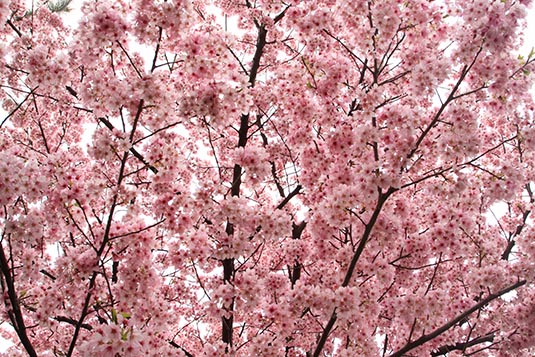 Once every year, for just a few days, Japan falls under a trance. The cherry blossom bloom heralds the beginning of spring. It’s Sakura time. It’s Hamami time – enjoying a meal under the cherry blossom – a must do custom for every Japanese. If you plan to be in Japan in March and April, it’s a good idea to refer to the forecast of cherry blossom. The meteorological department’s web site makes it a point to update the probable dates of cherry blossom across various regions of Japan. The bloom starts from up North and comes down South gradually. Visitors to Japan who have planned their trip, much in advance, based upon the weather reports, can be in for a surprise. The weather could change. Variations in temperature can bring forward or push back the bloom dates. Though locals can plan their holiday based upon the dates, they too get upset if the forecast goes haywire! Sakura is something Japanese can’t live without. 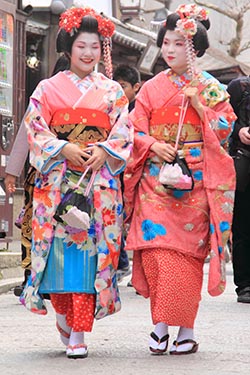 As per the forecast, the bloom for the year was to be on March 23rd in Tokyo, March 28th in Osaka and March 29th in Kyoto. I scheduled my business meetings in Osaka accordingly. As luck would have it, sudden chill delayed the bloom by a few days. Which meant I would miss Sakura viewing… at least not 100% of it. Well, the bloom in Kyoto was upwards of 25%. A few trees were 100%. Lucky me.
As per the forecast, the bloom for the year was to be on March 23rd in Tokyo, March 28th in Osaka and March 29th in Kyoto. I scheduled my business meetings in Osaka accordingly. As luck would have it, sudden chill delayed the bloom by a few days. Which meant I would miss Sakura viewing… at least not 100% of it. Well, the bloom in Kyoto was upwards of 25%. A few trees were 100%. Lucky me.
After landing at Kansai, Osaka’s international airport, I preferred taking the bus to town. There’s an option to take the train too. For Y1000, the comfortable bus took me to Namba station in just 40 minutes. Tickets need to be bought at the vending machine. At the time of writing USD1 fetched Y93. For sake of simplicity, my mind knocked off two zeroes from the Japanese price tags. What remained was the price in USD. Boy was Japan expensive! Japanese courtesy deserves a mention. May it be the bus driver or a counter salesman or a guide at an info booth or for that matter people on the street, they are so polite and helpful. They keep bowing… at times their upper body is almost at right angles to the legs. They must be doing this at least for hundred times in a normal day. No wonder they are so slim. Of course, their healthy diet of raw food must be coming in handy too. I was booked at the Hearton Hotel in Shinsaibashi area – quite central with easy access to subway train stations, commercial establishments, shopping and dining. I think that for a tourist Shinsaibashi is a good neighbourhood to stay at. Since it was a little late in the day and a bit tired from our flight, I took a taxi from Namba station. Just a 10 minute drive costing about Y1000. 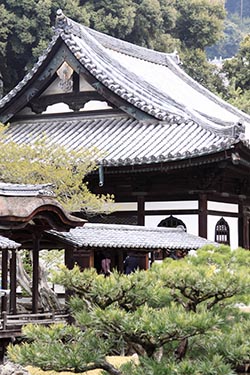 Hearton, primarily is a business hotel. It has a nice big lobby (by Japanese standards) and like most Japanese hotels small rooms, albeit complete with all amenities that included a Japanese Toilet System. Electronically managed, the guy on the seat can control the temperature of the toilet seat and the temperature and pressure of the water jets that are designed to give a clean and hygienic wash! In winters, I can imagine, folks spending more than normal time in this little room. All hotels that I stayed in during my week in Japan had such toilets. You will see a picture in my article on Tokyo.
Hearton, primarily is a business hotel. It has a nice big lobby (by Japanese standards) and like most Japanese hotels small rooms, albeit complete with all amenities that included a Japanese Toilet System. Electronically managed, the guy on the seat can control the temperature of the toilet seat and the temperature and pressure of the water jets that are designed to give a clean and hygienic wash! In winters, I can imagine, folks spending more than normal time in this little room. All hotels that I stayed in during my week in Japan had such toilets. You will see a picture in my article on Tokyo.
Next day was a Sunday. We were scheduled to leave for Kyoto. My business associate Mr Tsutomu Hanayoshi was kind enough to sacrifice his holiday to be with us for the day. In Japan, majority of the workforce in the city, live quite far away. So much so, that they prefer hiring a small room for themselves on the outskirts of the city leaving their family behind in far away homes. It’s only on weekends that they get to be with families! 10 AM sharp, as scheduled, Tsutomu was at the hotel. Very rarely would a Jap miss his appointment time. That holds true for all time tables – 10:23 means 10:23. From the Shinsaibashi underground station we went to Umeda (Y230). On the ground above, the trains on the Hankyu line will take us to Kawaramachi – Kyoto’s station (Y390) in about 40 minutes. 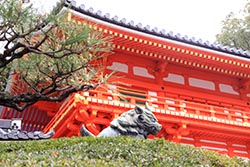 Kyoto was the imperial capital of Japan as also the largest city. However, post 16th century Osaka and Tokyo surpassed. The city was greatly destroyed during the wars in the 15th century. It was also the target for the atomic bomb but due to some internal war politics in the USA, the targets were Nagasaki and Hiroshima. Thanks to that gesture, one can see pre war construction whilst walking in and around Kyoto.
Kyoto was the imperial capital of Japan as also the largest city. However, post 16th century Osaka and Tokyo surpassed. The city was greatly destroyed during the wars in the 15th century. It was also the target for the atomic bomb but due to some internal war politics in the USA, the targets were Nagasaki and Hiroshima. Thanks to that gesture, one can see pre war construction whilst walking in and around Kyoto.
We walked a lot. Kyoto station opens out on Shijo Street the most important and happening thoroughfare of Kyoto. Crossing over the famous Kanogawa river and host of traditional and modern stores, tea houses and a Kabuki (theatre) we reached our first destination, Yasaka Shrine, about a km away. 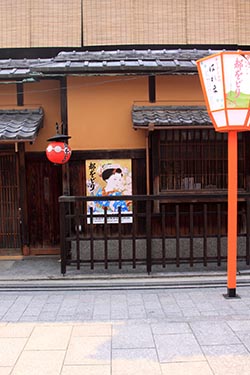 A Shinto shrine, the construction began in the year 656. The Shrine received Imperial patronage during the Heian period in 965. The shrine has a main gate, a hall and a stage. I was lucky to witness a Japanese wedding ceremony that was taking place centre stage. All around were guests, formally dressed including ladies in colourful traditional Kimonos.
A Shinto shrine, the construction began in the year 656. The Shrine received Imperial patronage during the Heian period in 965. The shrine has a main gate, a hall and a stage. I was lucky to witness a Japanese wedding ceremony that was taking place centre stage. All around were guests, formally dressed including ladies in colourful traditional Kimonos.
Just behind the Yasaka Shrine is the Mariyama Park – famous for its cherry blossom and Hanami. Sure enough, the park was decked up. Under the bloom, hundreds of families were enjoying their meals and Sake (liquor made from rice; can be enjoyed hot or chilled!). We took one of the seats under the bloom. I celebrated Hamami with a Diet Coke. A few meters up were two very old trees and to our pleasant surprise they were in 100% bloom – my first real Sakura sighting! The tree was all pink. The flowers were cascading down. Quite rightfully, these types are known as Shidare Sakura which literally translated means a waterfall. Walking through the Mariyama Park, we stepped out on the old side of Kyoto. The little street, with traditional Japanese houses on both sides, brought us to the gates of Kodai-Ji Temple which rests on a little hill encouraging you to negotiate a number of steps. The temple was established in 1605. The temple was ravaged by a series of fires. All that survived of the original buildings are the Kangetsu-Dai (Moon Viewing Pavilion); Kaisan-Do (Founder’s Hall); Garyoro (Reclining Dragon Corridor); Otama-Ya (Sanctuary) and Iho-An (Cottage of Lingering Fragrance). The temple garden was redesigned in 1579. Famous for its excellent stone layout, it is one of the finest gardens of its times. Right in the middle of the garden was a cherry blossom in full bloom. The entry fee to the temple is Y600 per person and includes to a visit in the museum within. -mariyama-park-kyoto-japan-1.jpg) From Kodai-Ji we walked all the way up, passing through a busy market, to Kiyomizu-Dera Temple. Atop a hill, the temple is surrounded by a lush forest and offers a spectacular view of Kyoto City. Now a world heritage site, the temple was built in 1633. Large verandahs and halls were constructed to accommodate pilgrims who came in big numbers. Midway down, pilgrims wait in long lines to have a sip of water trickling down from a mountain spring. The temple premises have many shrines too.
From Kodai-Ji we walked all the way up, passing through a busy market, to Kiyomizu-Dera Temple. Atop a hill, the temple is surrounded by a lush forest and offers a spectacular view of Kyoto City. Now a world heritage site, the temple was built in 1633. Large verandahs and halls were constructed to accommodate pilgrims who came in big numbers. Midway down, pilgrims wait in long lines to have a sip of water trickling down from a mountain spring. The temple premises have many shrines too.
Whilst passing through the market, coming from the opposite sides were two Geisha girls – with full make-up and attire. These girls sing, dance and play music at tea houses. These girls were more than happy to pose for the camera. Learned informed me later that they were actually Maiko girls. They would become Geisha after completing their apprenticeship. Honestly, I would fail to observe the difference. 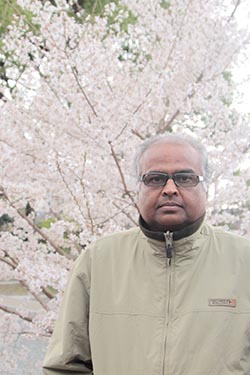 A long walk down brought us to Keninji Temple. Another set of shrines and gardens. Without bothering to get in, we continued walking and reached Hanami Koji Street in Gion area. We had our lunch, in a traditional Japanese restaurant – sitting down on fluffy cushions. We ordered a tempura set meal. A mix of lightly battered vegetables & shrimps served with rice and mizo soup as accompaniments. A good thing about Japanese restaurants is that you can look at various set meals (artificially created, but look so real) displayed in glass counters. Just point a finger to order. See, you don’t have to know Japanese language to enjoy Japanese food. Of course, we didn’t go through the motion as we had a local with us.
A long walk down brought us to Keninji Temple. Another set of shrines and gardens. Without bothering to get in, we continued walking and reached Hanami Koji Street in Gion area. We had our lunch, in a traditional Japanese restaurant – sitting down on fluffy cushions. We ordered a tempura set meal. A mix of lightly battered vegetables & shrimps served with rice and mizo soup as accompaniments. A good thing about Japanese restaurants is that you can look at various set meals (artificially created, but look so real) displayed in glass counters. Just point a finger to order. See, you don’t have to know Japanese language to enjoy Japanese food. Of course, we didn’t go through the motion as we had a local with us.
Our last visit of the day was to Sanjusangen-Do also known as Rengeo-In Temple. Since it was bit away, we decided to take a taxi. Poorer by Y12000 we reached the temple gates, just in time before the temple closes for visitors at 4PM. Entry fee is Y600 per person. The original temple building was established in 1164. However after the fire, it was reconstructed in 1266. The most fascinating structure in indeed is a hall that’s 120 meter long, made in Wayo (Japanese) style architecture. This hall (photography is not allowed) has 1001 statutes of Buddhist deity. Whilst 1000 statues are standing, there’s one very large statue in a sitting posture bang in the middle. 124 statutes were made in the 12th century and the remaining in the 13th century. On either side are the statues of Thunder God and Wind God. And between these two are 28 other statues of guardian deities. As you have noticed we visited many temples (Kyoto is known for that). I regret, not having the time to visit the very famous Golden Pavilion – a beautiful temple on the banks of a serene pond. Well, the priority on this trip was Sakura. We took a taxi back to the station and hopped on a train bound for Osaka. Kyoto Image Gallery  Photo viewer Photo viewer
|
|
|
Home |
Charity |
Feedback
Privacy Policy | Terms of Usage © YoGoYo.com. All rights reserved. |


















-mariyama-park-kyoto-japan-1.gif)
-mariyama-park-kyoto-japan-2.gif)
-mariyama-park-kyoto-japan-3.gif)






































